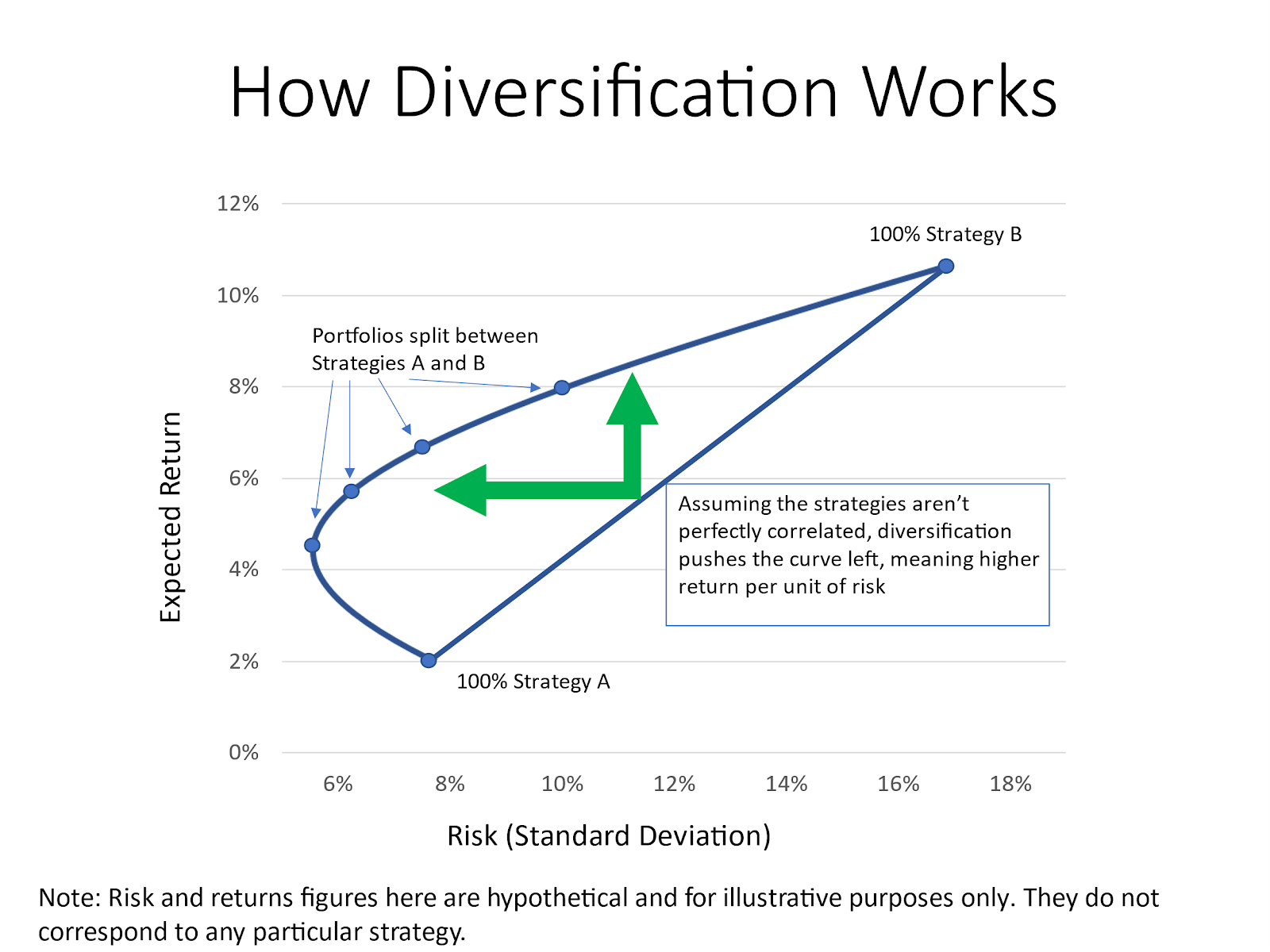How to Manage Portfolio Risk With Diversification
"Don't put all your eggs in one basket" means different things to different investors. Here's how to manage your risk with portfolio diversification.


With the stock market soaring to new all-time highs on what seems like a daily basis, managing your portfolio's risk might not be the first thing on your mind.
If you wait for a downturn, though, it's already too late. You don't want your roof to catch fire before you buy homeowner's insurance.
The best way to manage your portfolio's risk is through proper diversification. And the basic idea is simple enough: Don't put all of your eggs in one basket.

Sign up for Kiplinger’s Free E-Newsletters
Profit and prosper with the best of expert advice on investing, taxes, retirement, personal finance and more - straight to your e-mail.
Profit and prosper with the best of expert advice - straight to your e-mail.
But how much diversification is enough? And how do you know if your portfolio is functionally diversified vs apparently diversified?
Your 401(k) account might be spread across 10 different mutual funds. But if they all own substantially the same stocks, you're not diversified. You have the appearance of diversification without the benefits of diversification.
So, let's talk about the basics of diversification and how to ensure your portfolio actually reaps rewards from doing it the right way.
What is diversification?
The core principle of diversification is that prices of different assets move independently of one another and that holding a broad mix of assets reduces your risk.
For instance, when the stock market declines, bonds may increase in value, or real estate might remain stable.
Diversification also works within an asset class. Large-cap tech stocks such as Apple (AAPL) and Microsoft (MSFT) can both be affected by the general direction of the stock market.
But these are also distinct companies with risks and opportunities specific to their respective businesses. Apple might have a great quarter and see its stock soar at the same time Microsoft has a lousy quarter and sees its stock fall, or vice versa.
Perhaps the most important beneficial impact of diversification is a smoothing effect.
Over time, you get the weighted average return of the individual pieces of your portfolio. But, along the way, you suffer less of the up-and-down volatility.
Take a look at the graphic example below. This is for illustrative purposes and does not correspond to any particular strategy.
It shows how diversification increases your return for a given level of risk or lowers your risk for a given level of return.

Strategy A has an expected return of 2% with a risk, or "standard deviation," of 8%. Strategy B has an expected return of 11% with a risk of 16%.
A portfolio split 50-50 between the two will have an expected return of 6.5%, which is the average between 2% and 11%.
But the expected risk won't be the average risk of Strategy A and Strategy B. It will be lower. The straight line gets pushed into a curve.
This is the magic of diversification.
Don't worry if you get lost in the math. The key takeaway is that diversification done right will lower your risk for a given expected return or boost your expected return for a given level of risk.
And the lower the correlation between your assets, the bigger the diversification benefit.
How to check if your portfolio is diversified
So, how do you know if your portfolio is diversified? You can get technical if you're into that sort of thing.
Morningstar, Yahoo Finance, Portfolio Visualizer and a host of other services offer tools that allow you to measure how correlated the assets in your portfolio are and what your portfolio's expected risk and return would be. Your 401(k) provider may offer something similar.
Frankly, folks, you don't need to get all that precise.
In fact, leaning too heavily into the math can give you a false sense of security. Common sense and a couple of basic concepts will likely get you close enough.
One rule of thumb quoted by financial advisers is the "100 minus your age" principle. The idea here is that your allocation to stocks should be roughly equal to 100 minus your age.
If you're 70 years old, you should have about 30% of your money in stocks and the rest in bonds or other safer assets that tend not to move in step with the market.
This is a broad guideline, not an iron-clad law of the universe. Depending on your current wealth, your attitude toward risk and your other sources of income, your ideal number might be higher or lower than that.
You should also diversify within your stock allocation.
As a general rule, you probably don't want more than a couple percent of your portfolio in any single stock. (This rule can bend if you're an aggressive trader, again based on your wealth, your risk tolerance and your objectives.)
An S&P 500 index fund is arguably all the diversification you need, particularly for smaller portfolios. Something like the SPDR S&P 500 ETF Trust (SPY) will give you exposure to a broad swath of America's largest, most dominant companies.
But the S&P 500 isn't the only game in town, and there are stretches of years or even decades at a time when small-cap, mid-cap, real estate and foreign stocks outperform it.
Diversifying with mutual funds or exchange-traded funds that focus on these sectors can potentially reduce your risk and boost your returns over time.
Diversification is a lot like horseshoes and hand grenades: You don't have to hit an exact target.
Close is usually going to be good enough.
Related content
Get Kiplinger Today newsletter — free
Profit and prosper with the best of Kiplinger's advice on investing, taxes, retirement, personal finance and much more. Delivered daily. Enter your email in the box and click Sign Me Up.

Charles Lewis Sizemore, CFA is the Chief Investment Officer of Sizemore Capital Management LLC, a registered investment advisor based in Dallas, Texas, where he specializes in dividend-focused portfolios and in building alternative allocations with minimal correlation to the stock market.
-
 The New Space Age Takes Off
The New Space Age Takes OffThe Kiplinger Letter From fast broadband to SOS texting, space has never been more embedded in peoples’ lives. The future is even more exciting for rockets, satellites and emerging space tech.
By John Miley Published
-
 Ask the Editor: Four Reader Tax Questions
Ask the Editor: Four Reader Tax QuestionsAsk the Editor In our Ask the Editor series, Joy Taylor, The Kiplinger Tax Letter Editor, answers questions related to IRAs and other retirement accounts.
By Joy Taylor Published
-
 Home Insurance: How to Cut Costs Without Losing Coverage
Home Insurance: How to Cut Costs Without Losing CoverageNatural disasters are causing home insurance premiums to soar, but don't risk dropping your coverage completely when there are ways to keep costs down.
By Jared Elson, Investment Adviser Published
-
 Markets Roller Coaster: Resist the Urge to Make Big Changes
Markets Roller Coaster: Resist the Urge to Make Big ChangesYou could do more harm than good if you react emotionally to volatility. Instead, consider tax-loss harvesting, Roth conversions and how to plan for next time.
By Frank J. Legan Published
-
 Why Homeowners Insurance Has Gotten So Very Expensive
Why Homeowners Insurance Has Gotten So Very ExpensiveThe home insurance industry is seeing more frequent and bigger claims because of weather, wildfires and other natural disasters.
By Karl Susman, CPCU, LUTCF, CIC, CSFP, CFS, CPIA, AAI-M, PLCS Published
-
 Stock Market Today: Uncertainty Proliferates: Dow Loses 1,014 Points
Stock Market Today: Uncertainty Proliferates: Dow Loses 1,014 PointsWeaker-than-expected consumer inflation data wasn't enough to stabilize sentiment during another volatile day for financial markets.
By David Dittman Published
-
 Going Through Probate? How to Find the Right Attorney
Going Through Probate? How to Find the Right AttorneyJust having the skills and experience to do the job isn't enough. The probate attorney you hire needs to have the right temperament for your particular case.
By John R. Silva, Esq. Published
-
 Widow's Penalty: Three Ways to Protect Your Finances
Widow's Penalty: Three Ways to Protect Your FinancesHigher Medicare premiums, smaller Social Security payments, bigger tax bills … Financial changes can hit hard when a spouse dies. How to counter the blow.
By Ashley Terrell, IAR Published
-
 Four Ways Your Phone Can Help You Weather Market Volatility
Four Ways Your Phone Can Help You Weather Market VolatilitySmartphone apps can help investors make healthy decisions and maintain a disciplined investment approach — even when emotions try to steer them off course.
By Marco De Freitas Published
-
 Stock Market Today: Tariff Pause Triggers 3,000-Point Dow Rally
Stock Market Today: Tariff Pause Triggers 3,000-Point Dow RallyThe bond market is sending concerning signals as the Trump administration executes its rapid reordering of global trade relationships.
By David Dittman Published